Fixing a sourdough starter not rising is easy if you know what to do. Our troubleshooting sourdough starter guide covers everything you need to know for an active, bubbly sourdough starter. Keep reading to learn how to fix common sourdough starter issues so you can get back to baking your favorite sourdough bread recipes.
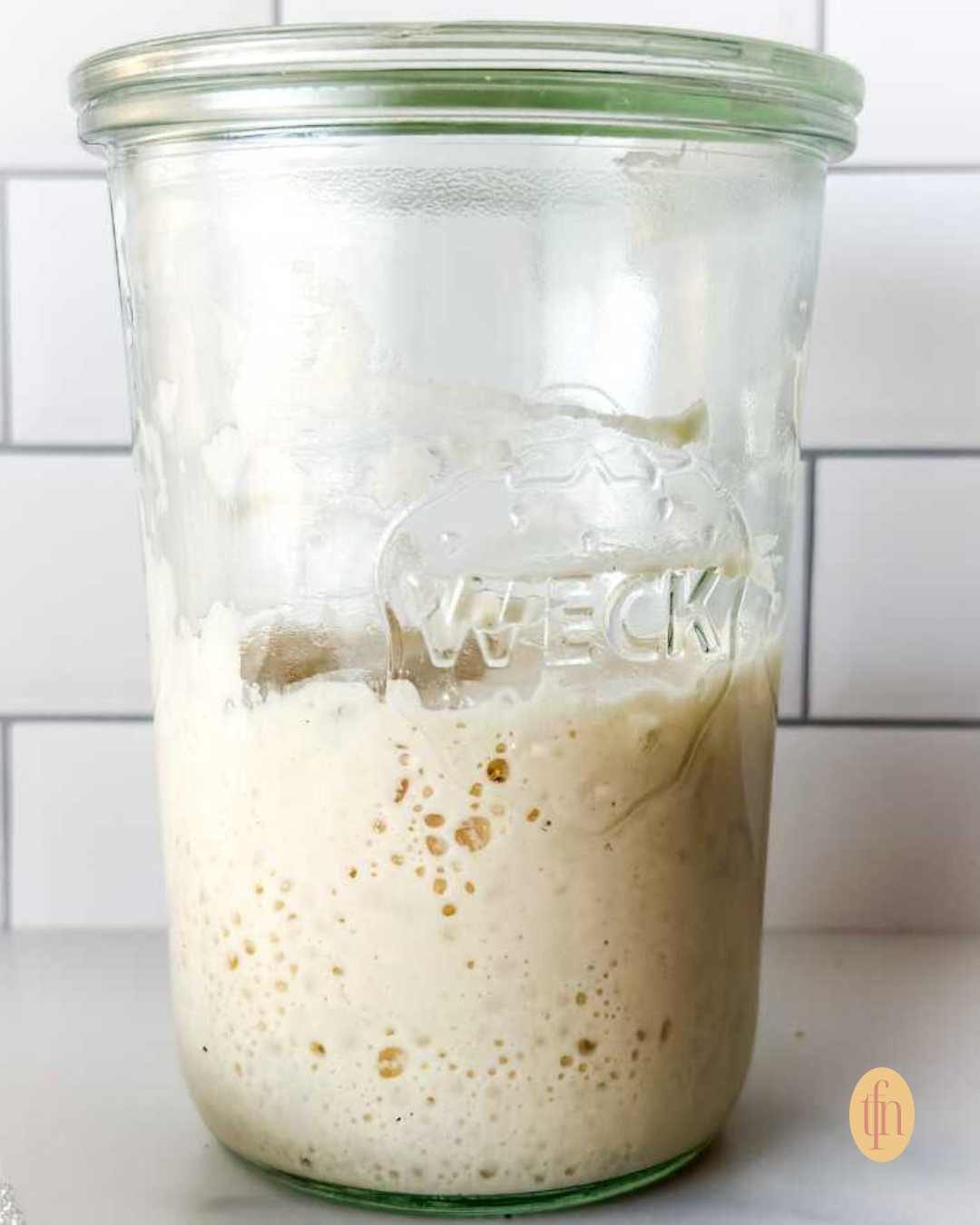
Did you know that we have about 40 sourdough recipes here at The Feathered Nester? It’s the perfect way to use up that sourdough discard. Check them out here: sourdough recipes and discard sourdough recipes
A healthy starter is the cornerstone of great sourdough bread; understanding how to keep it healthy and thriving is key to baking success. Whether your starter is sluggish, has a strange odor, or isn’t rising as expected, we have the steps you can take to get back to baking the perfect loaf!
Let’s get those issues fixed by troubleshooting your sourdough starter!
Content Covered Here
How Can I Tell If My Sourdough Starter Has Gone Bad?
Identifying a spoiled sourdough starter is crucial for your baking success.
Mold growth is one of the most apparent signs that your starter has gone bad. If you spot any mold or unusual colors, such as orange or pink tints, it’s time to discard your starter. Mold might present itself as fuzzy patches on the surface or sides of the container.
Another indicator is the smell; a healthy starter has a pleasantly tangy, acidic aroma. It could be spoiled if your starter emits an unpleasant odor—like rotten cheese or something putrid.
A vinegar or sour smell is common with hungry starters and simply means it needs to be fed.
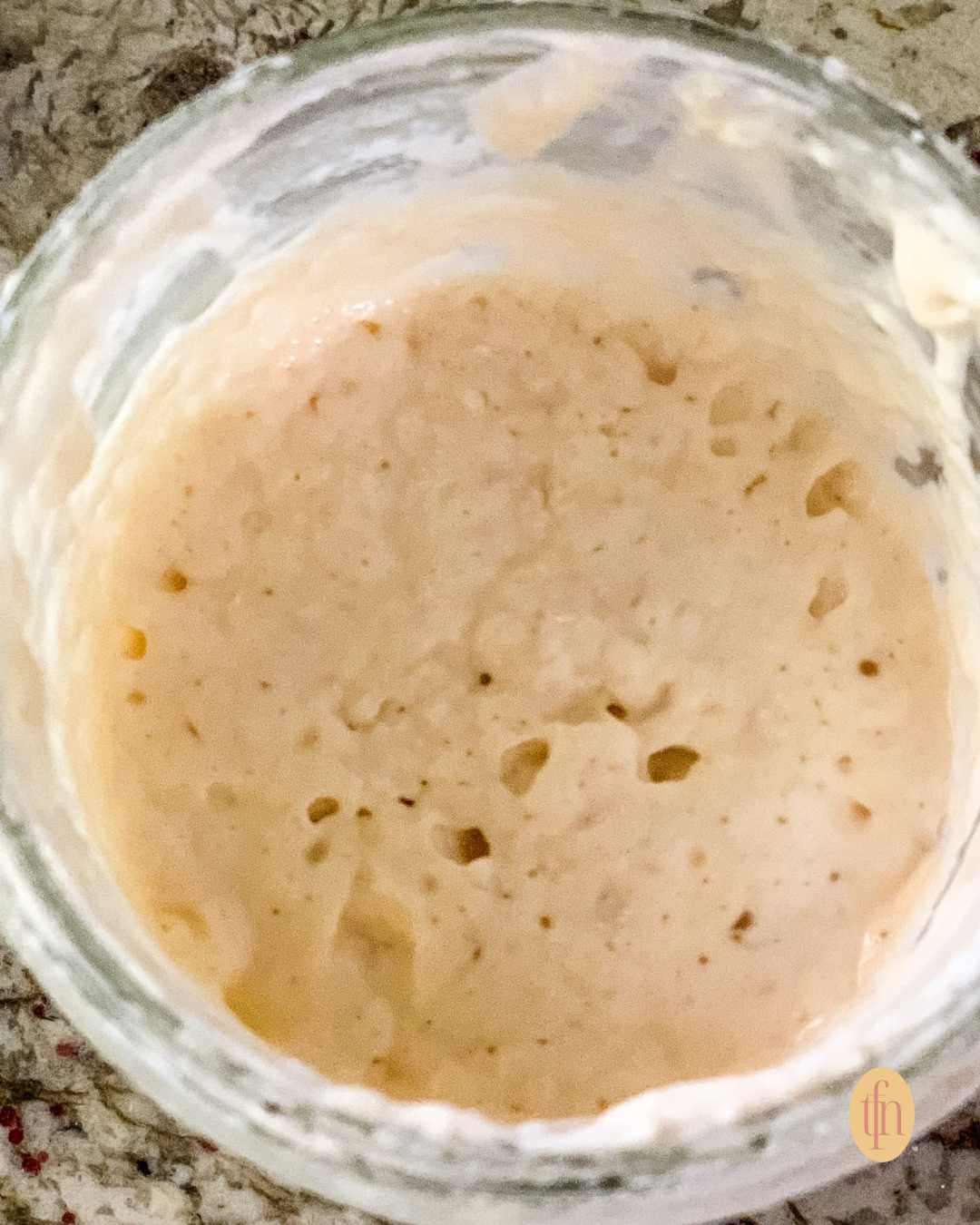
Why Is My Sourdough Starter Not Rising?
If your sourdough starter isn’t rising, there are several steps you can take to troubleshoot and remedy the issue:
Check Your Ingredients:
- Use unbleached all-purpose for feeding your starter. Bleached flour can inhibit growth as can some organic flours.
- Use filtered or dechlorinated water, as chlorine can harm the starter’s microorganisms. Spring water or bottled water are fine, too.
- If you’ve been using all-purpose flour, consider mixing in whole wheat or rye flour, which can help increase activity and rise.
Feeding Frequency:
- If your starter is kept at room temperature in a very warm environment (over 80ºF), has a dried layer on top, or you missed a few feedings, increase your feedings to once every 12 hours or store it in the refrigerator.
- If it has been neglected (in the fridge without feeding for 3 or more weeks) or on the countertop without feeding for 2 or more days, then a series of three feedings done 12 hours apart should make it active again.
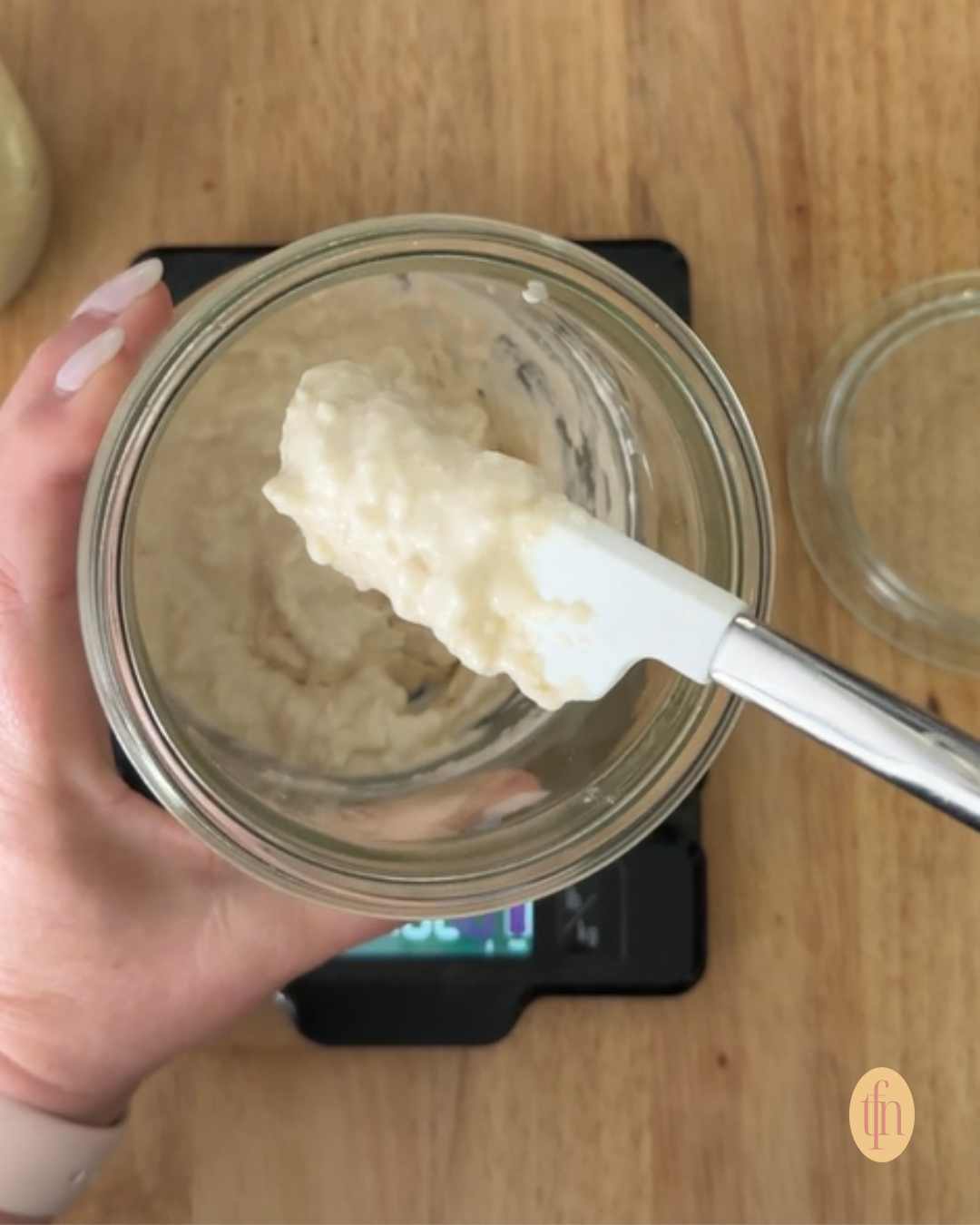
Feeding and Discarding Regularly:
- Feed Equal parts by weight of flour and water. If you don’t have a scale, use twice as much flour as water. For example: use 1/2 cup of water to 1 cup of flour.
- Discarding: To maintain high fermentation activity, discard (or use in a recipe) half of your starter before each feeding. You can use your discard in every one of our Sourdough Recipes.
Searching for some scrumptious ways to use your sourdough discard?
We’ve got a delightful array of recipes for you to try, including tasty sourdough discard scones, fluffy pancakes made with sourdough discard, and our irresistible sourdough cinnamon rolls recipe.
Optimize Temperature:
- To encourage fermentation, maintain a consistent, warm environment between 70°F and 85°F (21°C and 29°C).
- I use a warming mat, like those for seed germination or kombucha fermentation, to provide a warmer environment in the cooler months.
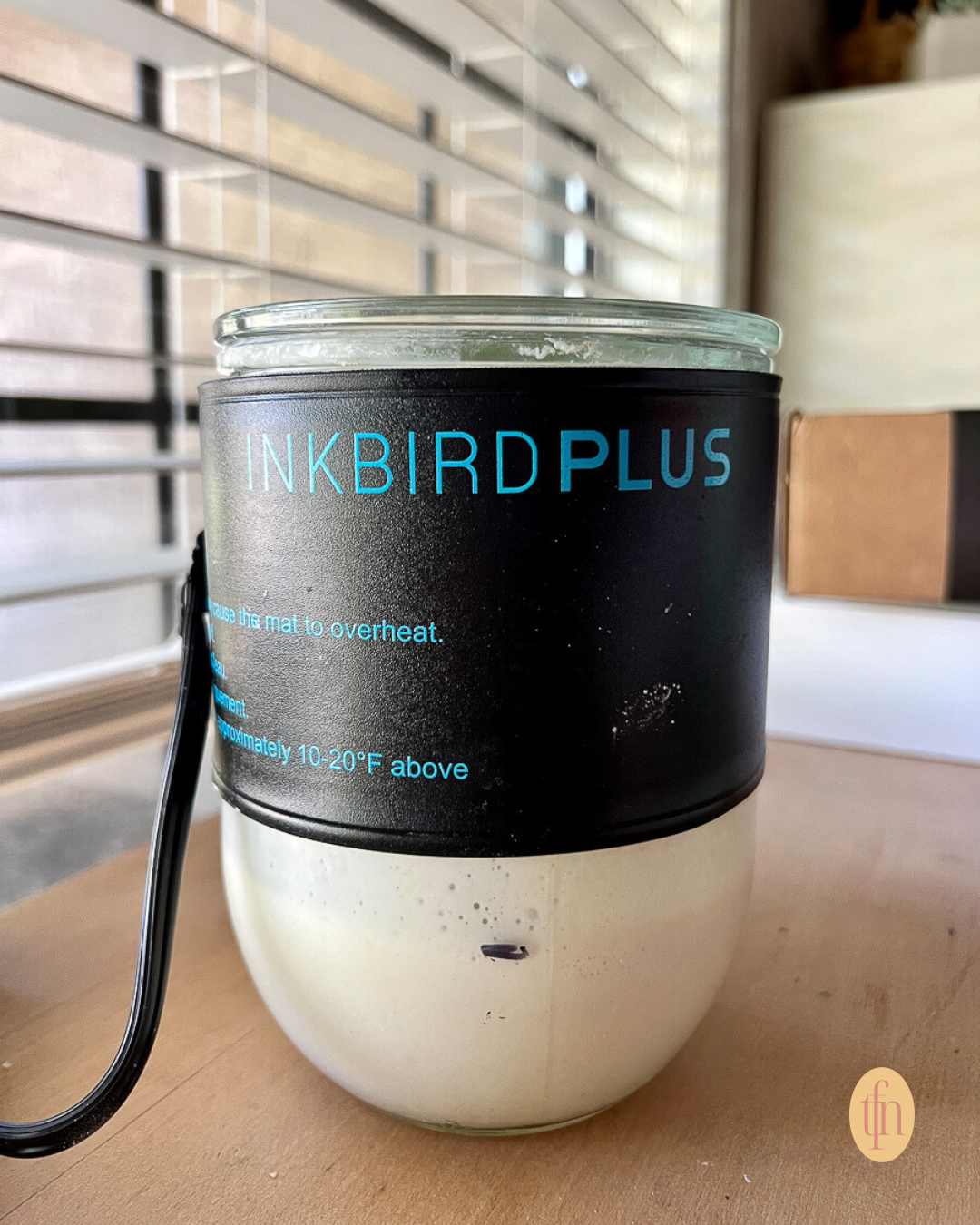
Patience and Persistence:
- Sometimes, it just takes a bit of patience. Continue the care routine, and don’t get discouraged.
Remember, creating a lively sourdough starter can take time and may require a bit of adjustment to find the right balance for your specific environment and ingredients.
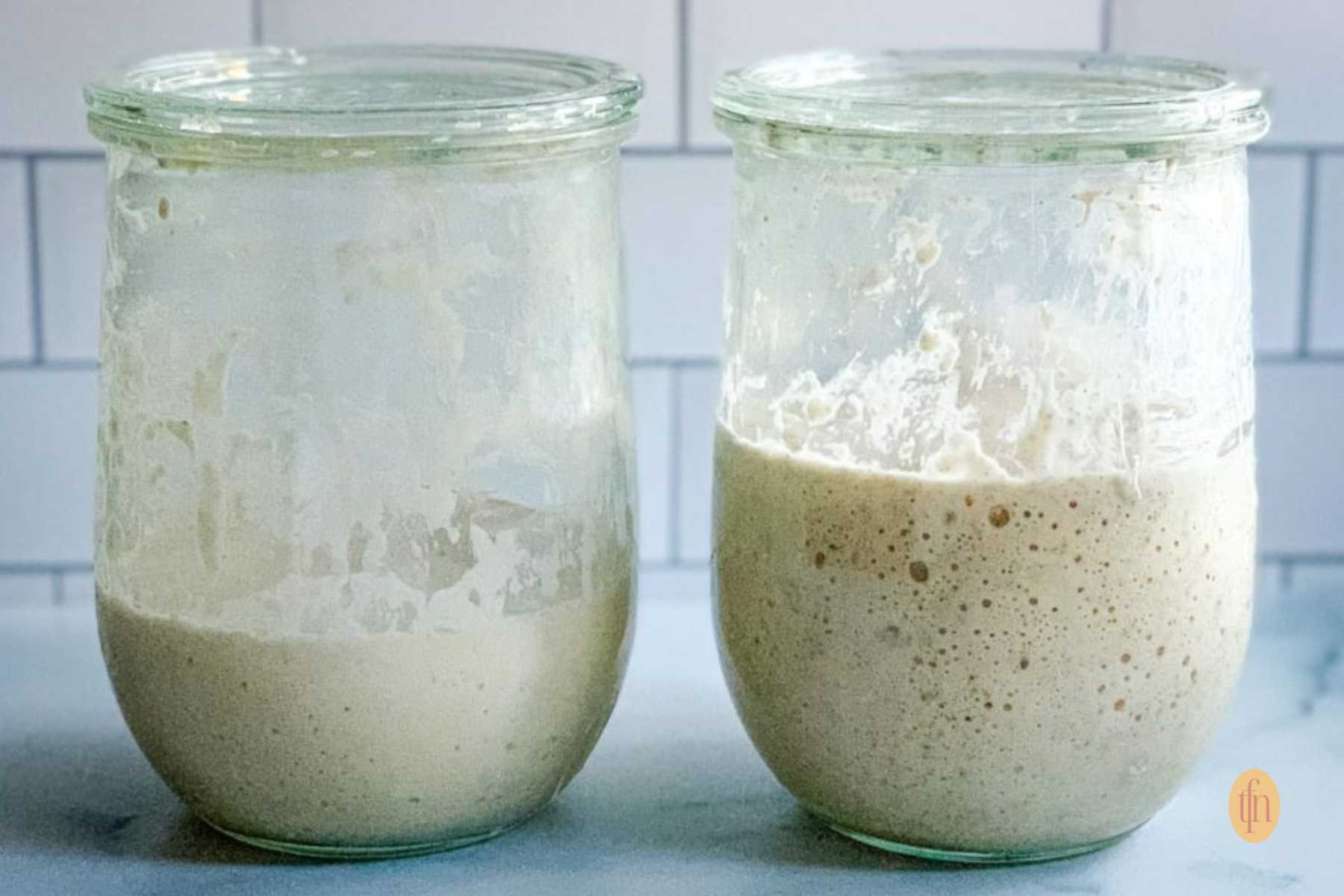
How Can I Revive a Sourdough Starter That’s Been Stored in The Fridge?
If your sourdough starter has been neglected in the refrigerator for several weeks, you can usually bring it back to life with a bit of care. Here’s a straightforward guide on how to revive your refrigerated sourdough starter:
- Assess Your Starter: Check for any signs of mold or unpleasant odors. If it looks and smells okay, it’s likely still viable. Discard any dark liquid (hooch) on top, a harmless sign of hunger.
- Discard and Feed Your Starter as you usually would.
- Wait for Activity: Place your starter in a warm spot, between 70-85°F.
- Re-Feed Schedule: Over the next 24 to 48 hours, feed your starter every 12 hours with the same 1:1:1 ratio (starter: flour: water).
- Look for Bubbles: Observe the mixture for bubbles and a pleasant, yeasty aroma. This indicates that the natural yeasts are active and the starter is alive.
- Testing Viability: Once it doubles in volume within 4-6 hours of feeding, it’s ready to bake. Skip the “float test” (you can google it). It has never worked for me.
Remember, patience is essential when troubleshooting sourdough starter and reviving it. It may take several days for dormant yeast to become fully active again. During this time, you’re nurturing the good bacteria and yeast back to health for your delicious sourdough recipes.
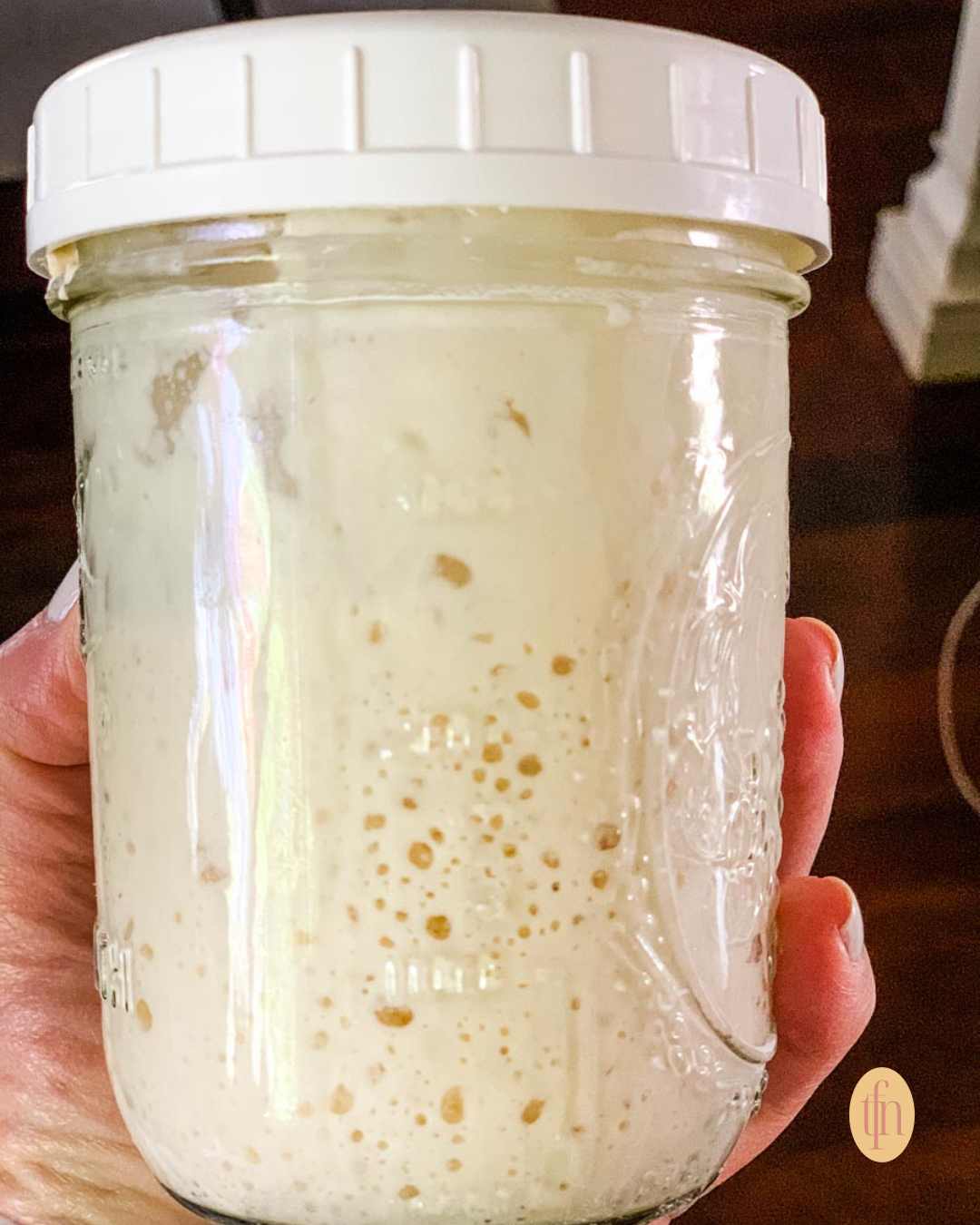
Signs That a Sourdough Starter Is Not Thriving:
- Lack of Bubbles: An active starter is characterized by a multitude of small and large bubbles. If your starter has stopped producing bubbles, it is a sign that the natural yeast in it is not active.
- Unpleasant Odor: A healthy sourdough starter has a tangy, pleasant smell similar to yogurt or fermentation. An unpleasant, putrid odor can indicate bacterial contamination.
- Not Rising After Feeding: Typically, a healthy starter should double in volume within 4-6 hours after being fed. If yours does not, the yeast might be inactive or dead.
- Visible Mold Growth: Any signs of mold, including fuzzy spots or discoloration, mean your starter has been contaminated.
- Changes in Color: Your starter should maintain a creamy, off-white color. The appearance of any orange or pink hues indicates unwanted bacterial growth, and it would be safer to discard your starter at this point.
Troubleshooting these issues involves adjustments in feeding, temperature, and possibly starting afresh if your starter shows signs of mold or has an odd color. A responsive routine to these cues will help sustain a robust, active sourdough starter.
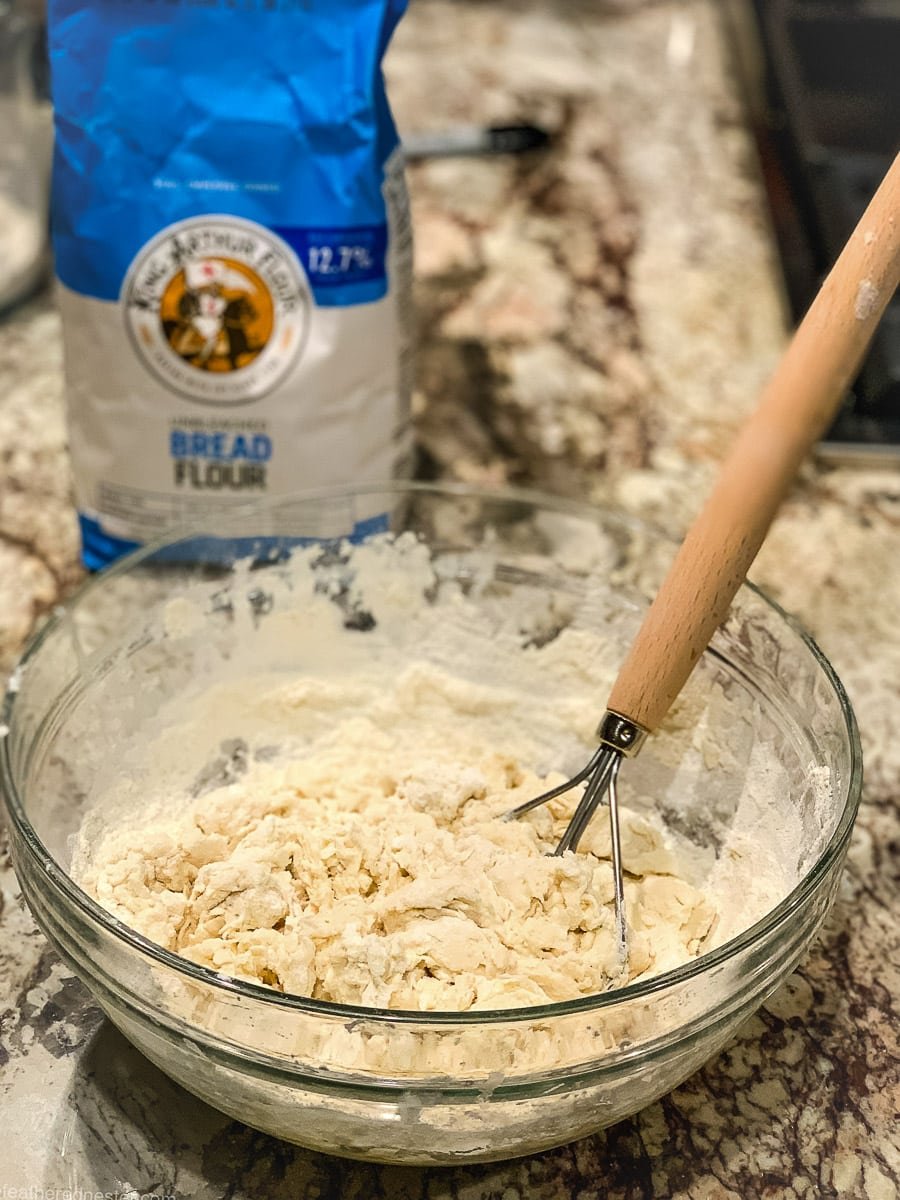
What Happens If It’s Bubbling But Not Rising?
When your sourdough starter is bubbling but not rising, this indicates that it’s alive, as the bubbles are a result of fermentation. However, it also suggests that the starter lacks the strength to increase in volume, which is essential for a good rise in your sourdough bread.
Possible Reasons:
- The temperature is too cold for fermentation.
- An imbalance in the flour-to-water ratio can affect the starter’s ability to rise.
- Bleached all-purpose flour or organic all-purpose flour can inhibit growth.
- Underfeeding your starter can deplete its resources, preventing it from rising. Conversely, overfeeding can dilute the natural yeast concentration.
- Changing brands of flour can cause a temporary loss of activity until the sourdough starter adjusts to the new flour.
Actionable Steps:
- Adjust Temperature: Find a warmer spot or use a warming mat to maintain a consistent temperature.
- Review Ratio: Use the correct flour-to-water ratio, 1:1 by weight.
- Establish Routine: Set a regular feeding schedule, adjusting the frequency and amounts as necessary.
If after these adjustments your starter still isn’t rising as it should, continue to monitor and make incremental changes. Patience is key; it might take a few days for your starter to develop the necessary strength.
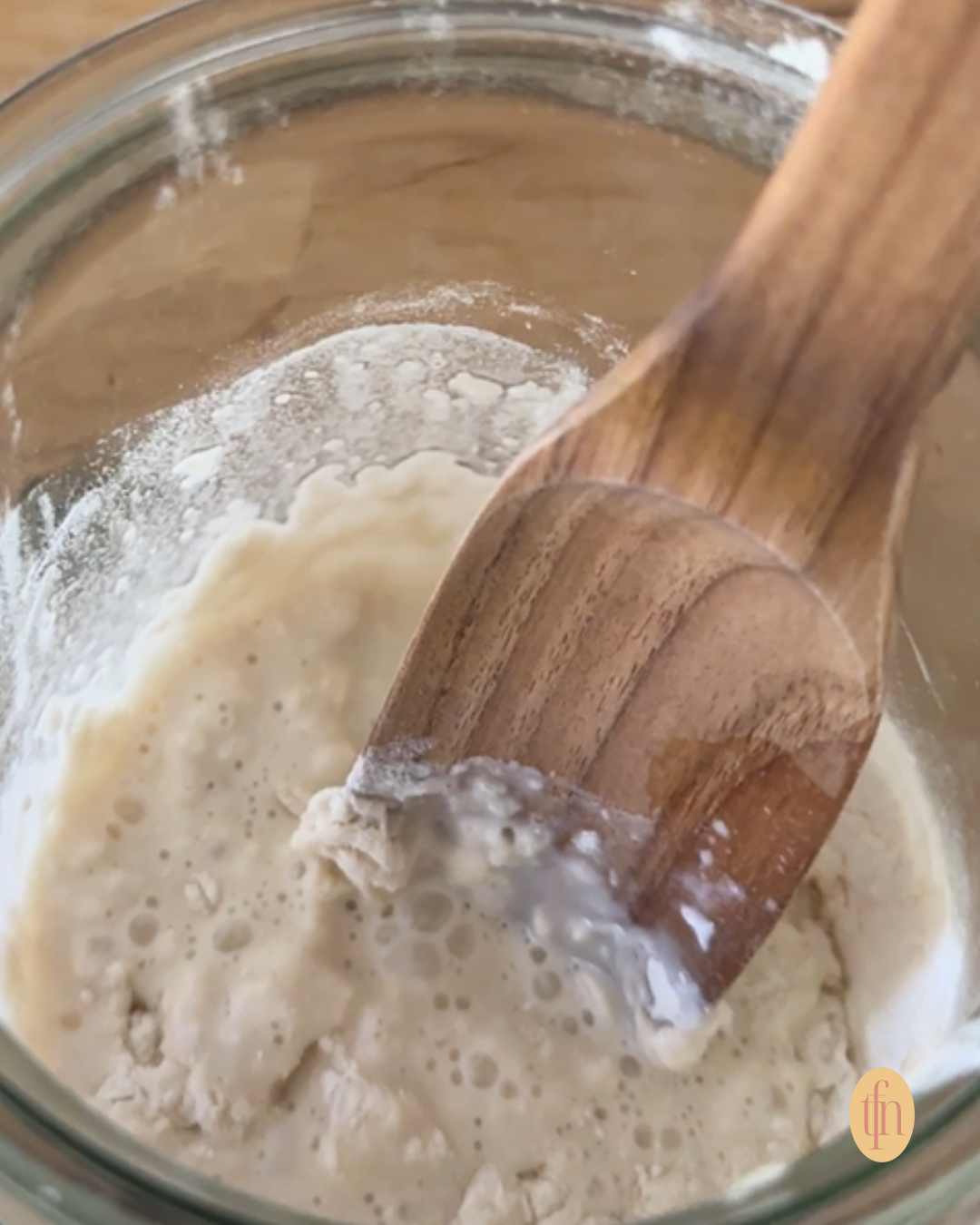
My Starter Rose and Bubbled For a Few Days But Now It Looks Inactive
It’s common for a sourdough starter to exhibit a lot of activity in the first few days and then appear dormant. This is usually not a cause for concern.
When you mix flour and water, you create a friendly environment for both wild yeast and bacteria. The first burst of activity is usually due to bacteria, which can produce gasses that cause the mixture to rise. However, these bacteria do not survive well as the environment becomes more acidic and the yeast begins to dominate.
If you follow the tips and recommendations in our sourdough starter for beginners post then you are on track.
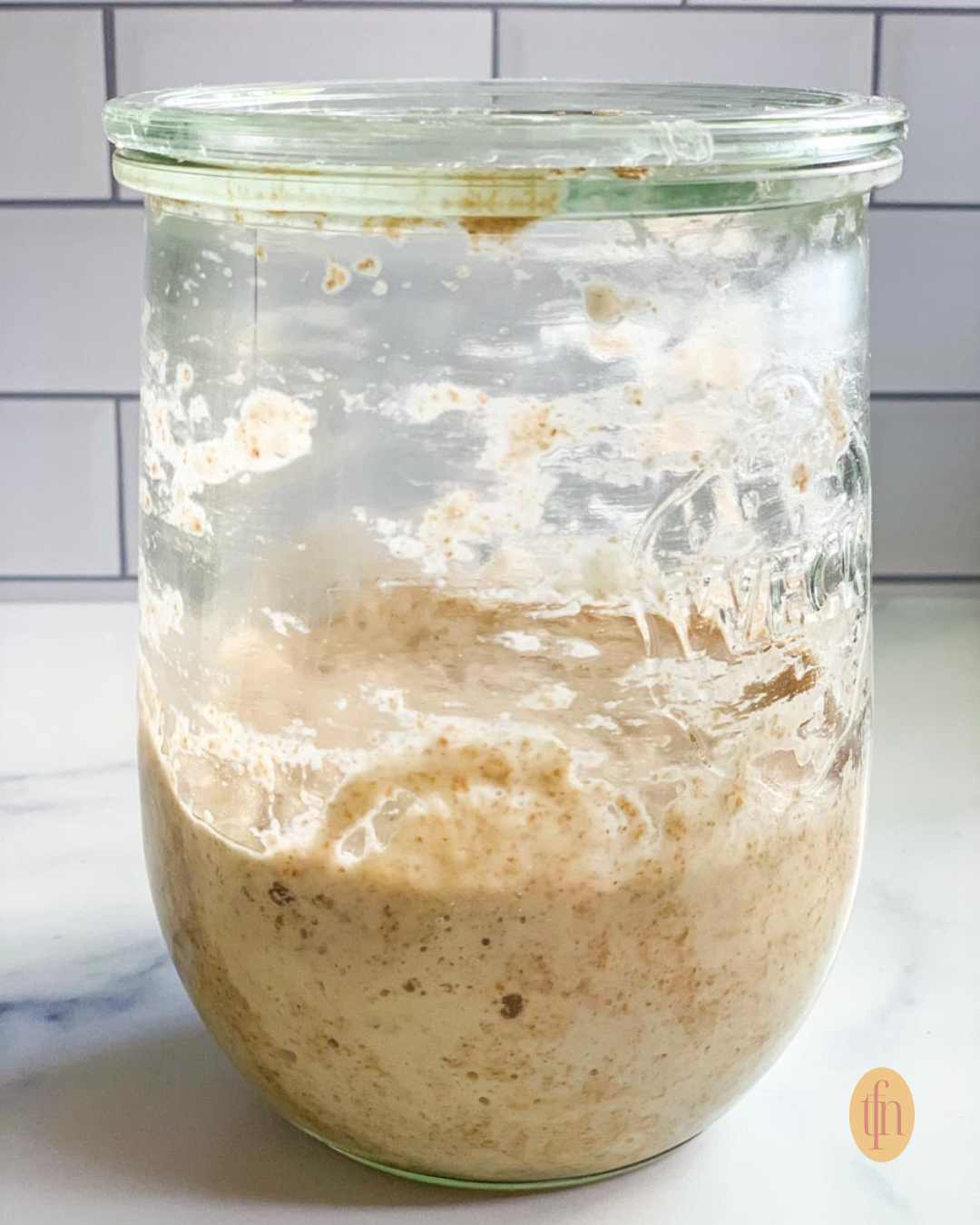
Why Does My Starter Smell Like Acetone (Nail Polish)?
If your sourdough starter has a scent reminiscent of acetone or nail polish remover this is a sign tha it’s hungry and needs feeding. This sharp smell results from excessive fermentation, producing acetic acid, which shares similar volatile compounds with acetone.
Here’s what’s happening in your starter:
- Yeast Activity: The yeasts in your sourdough starter are very active and consume the available nutrients rapidly.
- Acidic By-products: When the yeast runs low on food, it produces more acetic acid, which has a potent acetone-like smell.
- Warm Temperatures: Warmth accelerates fermentation, so a sourdough starter often develops this smell faster in a warmer environment.
To remedy this, feed your starter regularly. Feed daily If you keep it on the kitchen counter and your room is between 70º and 80ºF. If you keep it in the fridge, feed it every 1-2 weeks.
| Scent | Action Required |
| Acetone | Increase feeding frequency |
| Musty/Cheesy | Assess for mold, you may need to start over |
Should I Keep The Lid On Or Off The Jar?
When maintaining your sourdough starter, deciding whether to keep the lid on or off the jar is important for its health. Fermentation requires some air, so I recommend using a jar with a lid that is not airtight, such as a lid without a rubber gasket or sealing ring around it.
Alternatively, you can use a rubber band over a layer of plastic wrap with a few tiny holes in the top atop your jar.
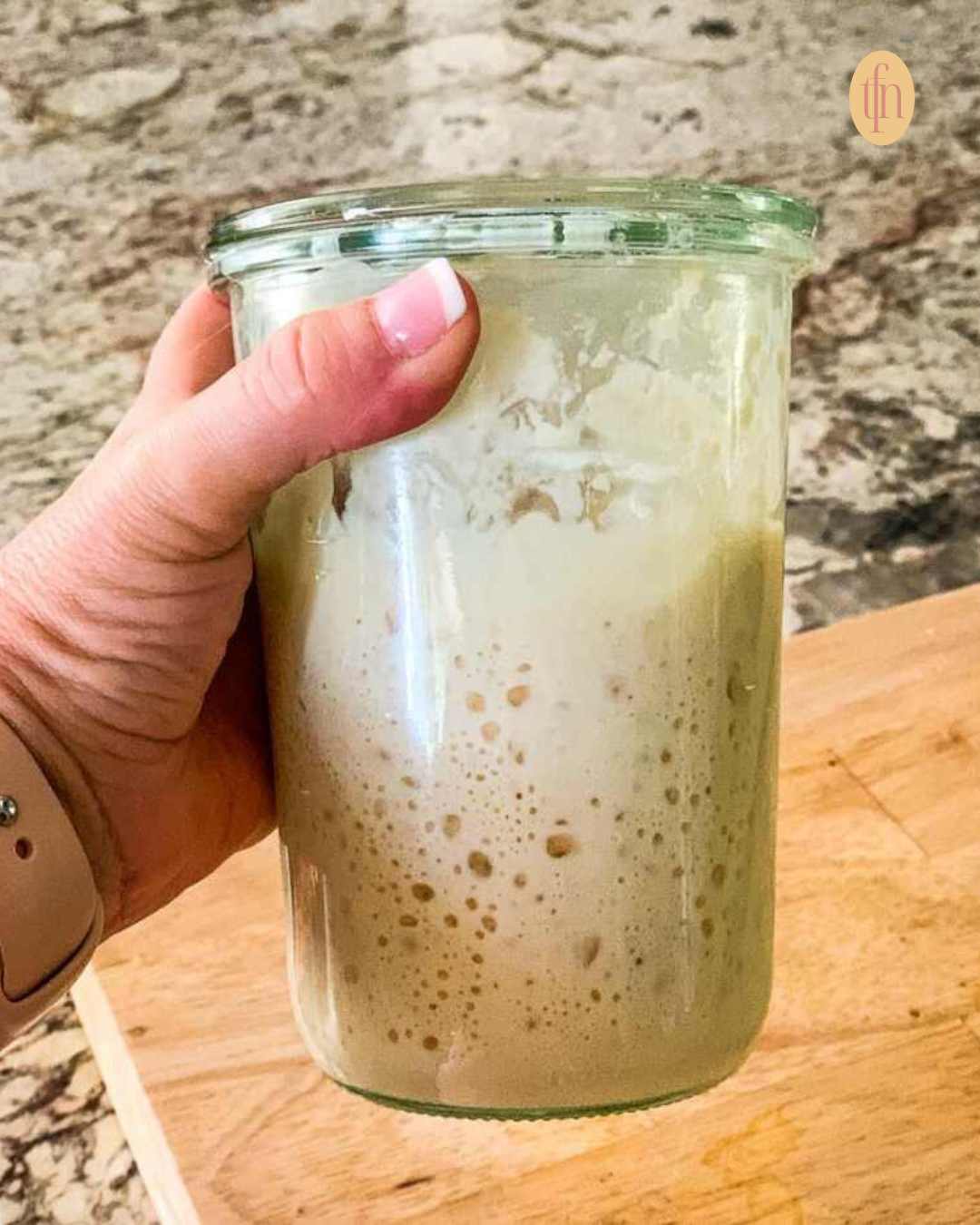
What Type Of Flour Is Best For Jump-Starting A Sluggish Starter?
When your sourdough starter is not rising, the right flour is key. You want a flour that’s high in nutrients to encourage the natural yeasts and bacteria to flourish.
Whole Grain Flours
Primarily, whole grain flours like whole wheat and rye are excellent for giving your starter a boost. They’re nutrient-dense, providing more of the vitamins, minerals, and fibers that the microbes in your starter feast on.
- Whole Wheat Flour:
- High in nutrients
- Promotes rapid fermentation
- Rye Flour:
- Often results in a noticeable difference in activity
- Can be mixed half and half with your current flour for several days to enhance growth
If you can get your hands on freshly milled flours, that’s even better, as they retain more of the natural benefits lost in the processing of store-bought flour.
Remember, using these flours is not just about getting a rise from your starter; it’s about establishing a stable and robust microbial community that will yield delicious sourdough bread. Stick with whole grains, and you’re on the right track to a healthy and bubbly sourdough starter.
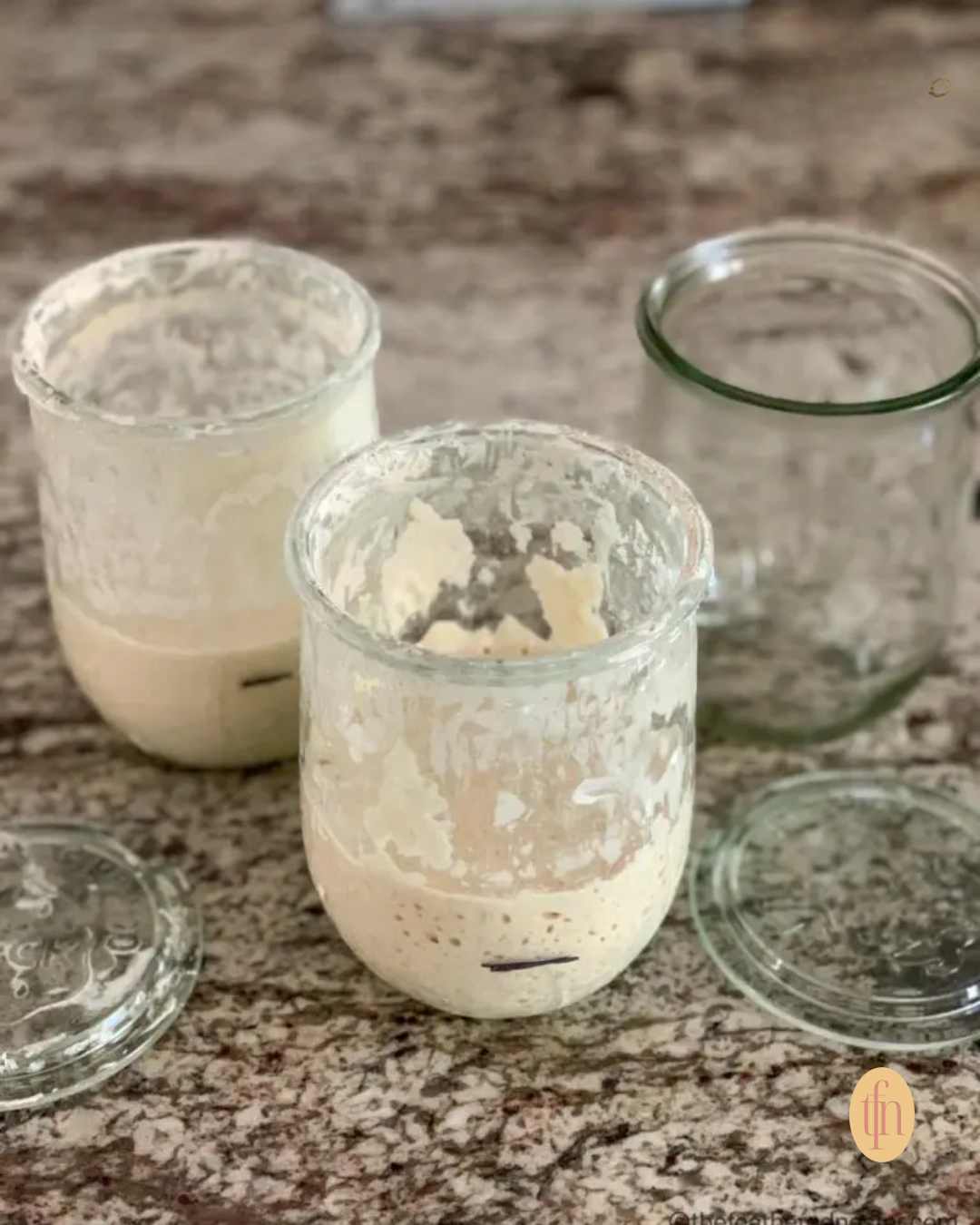
Do I Really Need To Use Filtered Water?
Water quality can be more significant than you might assume when tending to your sourdough starter. Your starter’s health is paramount, and unfiltered tap water — which usually contains chlorine — can inhibit the growth of the yeast and bacteria essential for your starter. Well water, on the other hand, is generally free from chlorine.
If you lack a water filter and rely on municipal (city-provided) water, you can simply leave your water uncovered overnight to allow chlorine to evaporate.
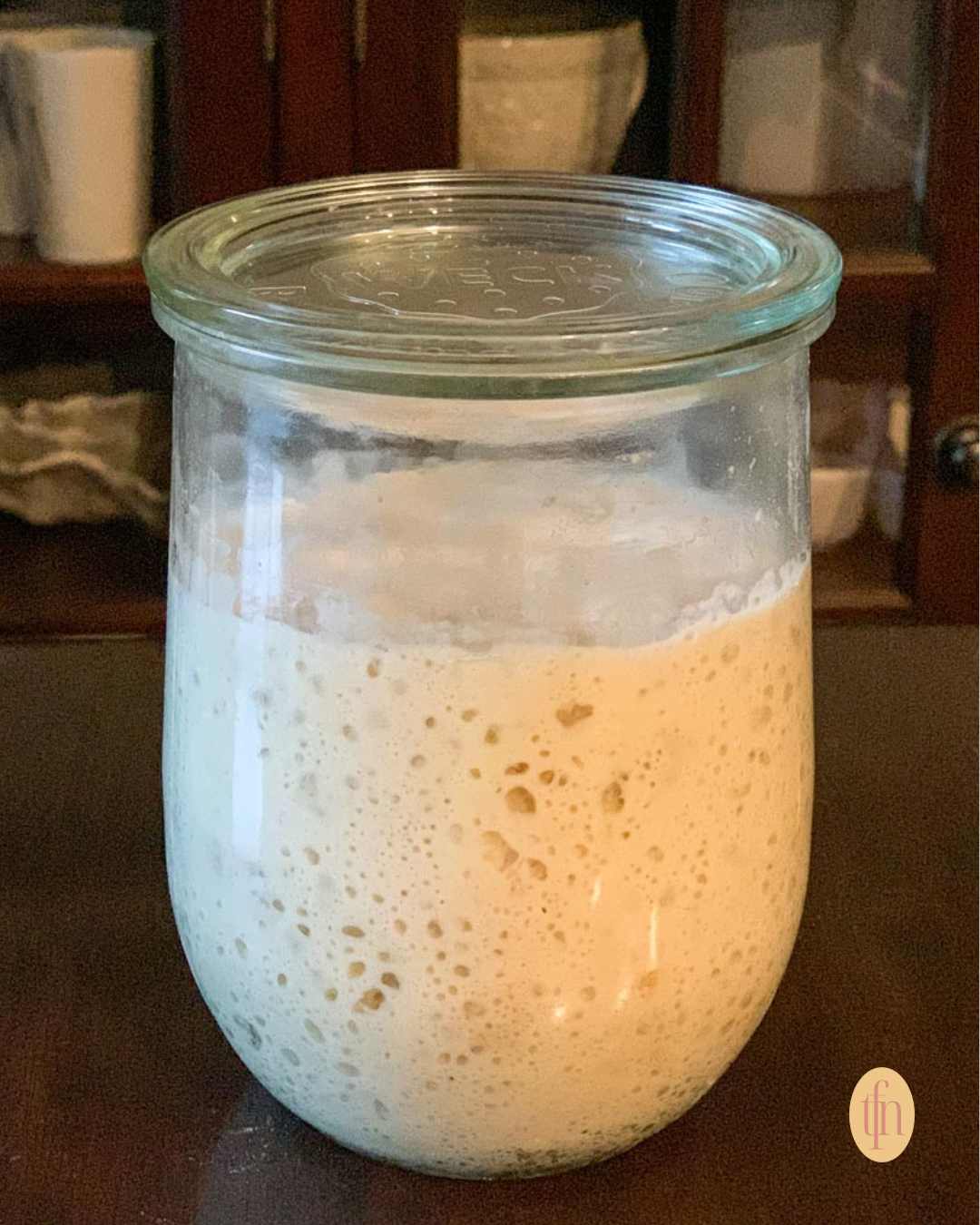
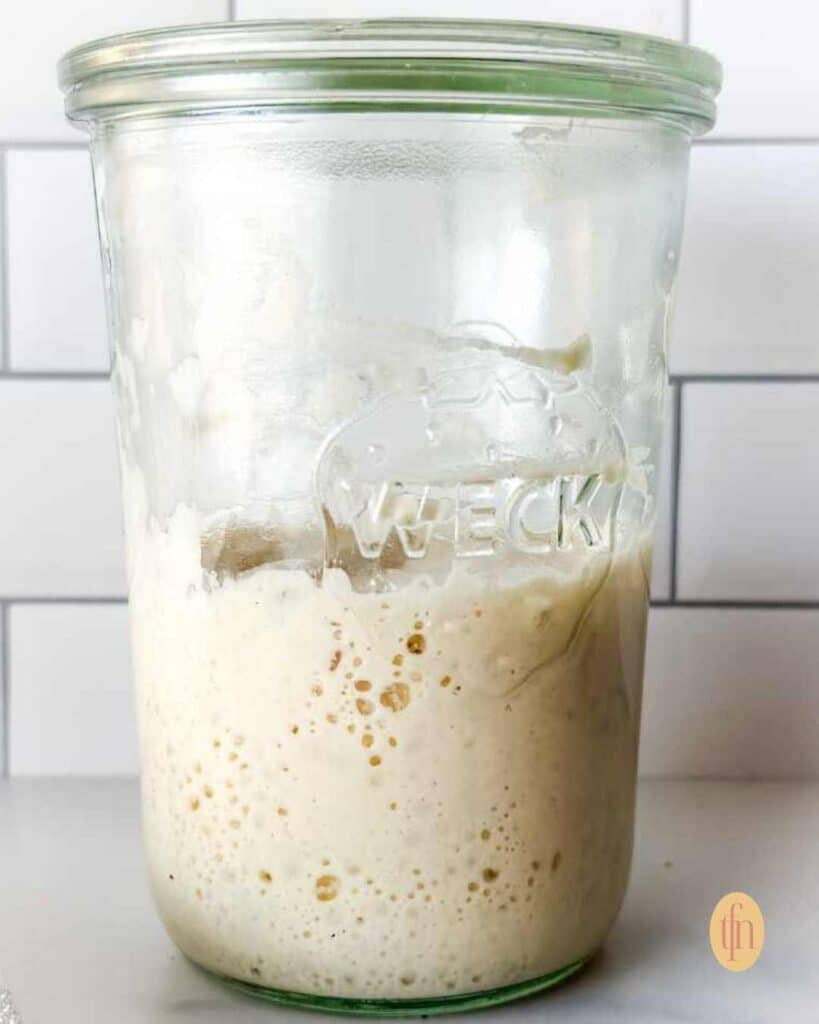

Alexis Rainey says
My husband and I have been trying to start a sourdough starter for a bit now. We originally started with rye flour, but when we switched to an unbleached all purpose flour(rye flour is expensive) all signs of activity are gone. We don’t have a rise and there are hardly any bubbles. We have continued to feed it regularly a 1.1.1. ratio for a few days but there is still nothing to see. Have we killed our starter or do we just need to be more patient?
Danielle - TFN Team Member says
Hi! I have a couple questions before I can give you advice- is it the same “starter” that you started with rye and then switched to all purpose? Or did you start over with a new one? How many days have you been feeding it in a row? What’s the temp like inside your house, humidity? IF you started with rye and switched to all purpose you might need to start over with just all purpose, the switch might have been too much. If you have a “new” one with all purpose let me know how many days and we will go from there.
Susan says
My starter has been rising after 4 hours but I’m afraid of it deflating before the 12 hour feeding. I live in Texas where it’s warmer. I’ve read to stir it once or twice in between feedings so it gets plenty of oxygen so it deflates when I stir it but rises again. Am I doing it correctly or should I stop stirring it? And if I stop stirring, what happens if it deflates before it’s feeding.
Gianne - TFN Team Member says
You’re doing great—and your instincts are spot on! In warmer climates like Texas, sourdough starter tends to ferment and rise much faster. Stirring your starter once or twice between feedings is perfectly fine and actually helpful! It redistributes the yeast and bacteria, introduces oxygen, and can prevent overly fast fermentation or a dense top layer. It’s normal for the starter to deflate a bit when you stir—it should rise again if it’s healthy and active, just as you’ve observed.
If you choose not to stir and the starter deflates before the 12-hour mark, don’t worry. That just means it’s peaked and begun to fall, which is part of its natural cycle. It doesn’t hurt the starter—it just might be a bit more sour by the time you feed it again. If this is happening consistently, you can either stir mid-cycle or adjust your feeding schedule slightly to better match your environment. You’re definitely on the right track!
Jan Smits says
I am new to baking sourdough bread….thank you for your good instructions and recipes. I like your sourdough sandwich bread.